FIVE TIPS FOR CHECKING YOUR TIRES:
REMEMBER T.R.E.A.D.
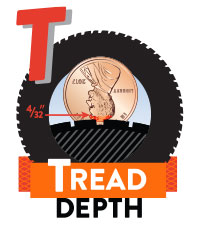
T = TREAD DEPTH
In a new tire, the largest grooves (“major grooves”) are typically 10/32″ or 11/32″ deep. The depth of these grooves in a tire’s tread pattern is called the “tread depth.”
Tread depth decreases as the tire is used. To be safe, a tire should have a tread depth of at least 4/32” . An easy way to determine your tread depth is by placing a penny into a major groove, with President Lincoln’s head pointing downward. If the hair on top of Lincoln’s head is visible, as in the diagram on the right, the tire tread is dangerously worn and needs to be replaced.
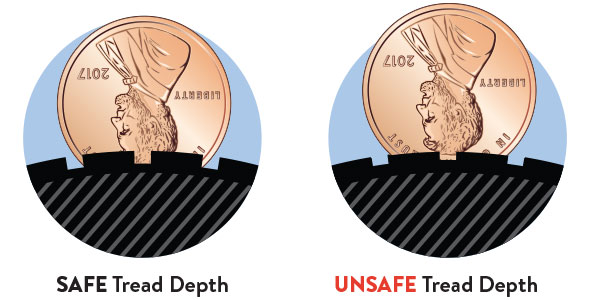
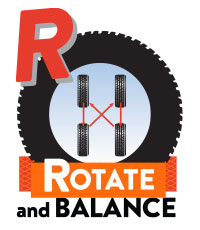
R = ROTATE AND BALANCE
Your tires should be rotated and rebalanced periodically to prevent uneven wear. Generally, weight isn’t evenly distributed throughout a vehicle, affecting how the load is distributed on your tires. In addition, certain road conditions can affect the tires on one side, the front, or the rear, more than others.
To prevent these variables from having a negative impact on your tire, your tires should be rotated every 6 months or 5,000-6,000 miles. Have them professionally balanced every 3,000-6,000 miles. If your steering wheel is vibrating when you drive at highway speeds, have your tires checked right away, as this can be a sign that they’re out of balance.
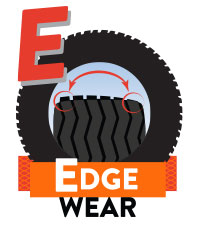
E = EDGE AND SHOULDER WEAR
If there is less tread at the tire’s edge (also called shoulder) than in the middle, your tire may need to be replaced or rotated. This could be a sign that the tire has not been inflated properly with the recommended air pressure.
Uneven wear patterns can develop if tires have not been regularly rotated and properly aligned. Tires with uneven wear can make your vehicle more difficult to control. Your mechanic or car dealer probably recommends rotations every 5,000 to 6,000 miles or every 6 months. They may also advise you to have your tires balanced or aligned every 3,000-6,000 miles.
In addition to uneven wear on the part of the tire that meets the road, the sidewalls of your tires shouldn’t exhibit any cracking or bubbling. These are indications that the tire may fail. Any tire that shows these signs should be replaced immediately.
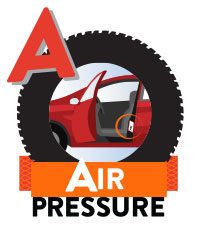
A = AIR PRESSURE
Tire manufacturers specify the recommended inflation for each type of tire in pounds per square inch or PSI. That number is usually found inside the front door frame of the vehicle, stamped on the sidewall of the tire, and printed in the tire manual. Tires should never be inflated beyond the maximum pressure indicated on the sidewall.
To measure air pressure, remove the cap from the valve stem. Place a tire gauge over the valve stem and apply even, firm pressure. When have your reading, remove the gauge and add air if needed. Remember to replace the cap onto the valve stem, then check the rest of your tires.

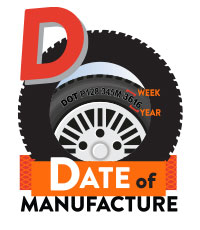
D = DATE OF MANUFACTURE
The rubber on a tire ages whether you use the tire or not. Exposure to direct sun accelerates this process, but even tires stored in a cool, dark environment aren’t safe if they’re too old. Tires that are technically new may already be too old for safe use when they are too far past their manufacturing date. Always check the DOT number on any tires you purchase new.
Don’t put any tire on your vehicle if you don’t know how old it is! Here’s how to find out.
Every tire is required by federal law to have a Department of Transportation (DOT) number imprinted on the sidewall that indicates its true age.
If your tire was manufactured after 2000, look for a 12-digit series of letters and numbers on the sidewall. The last four numbers indicate the week and year of the tire’s manufacture. For example, if the last four numbers are “4213” then the tire was manufactured in the 42nd week of 2013. Since it’s over four years old, it should probably be replaced. If the last four numbers are “3417” as in the photo below, then the tire was manufactured in the 34th week of 2017, and it’s probably fine to use for a few more years.
If you only find a four-digit DOT number, look on another tire on the vehicle or on the back side of the tire. Full DOT numbers are only printed on one side of the tire.
If your DOT code is only 11 digits long, then it was manufactured before 2000. Any tire that old should be replaced!
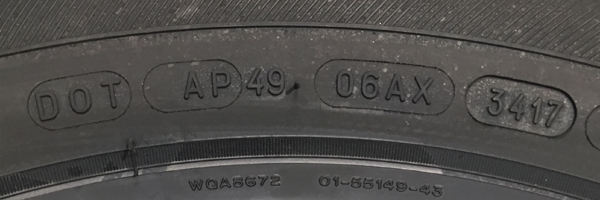
AND… CHECK FOR RECALLS!
Like all products, tires may sometimes be designed or manufactured in a way that makes them unsafe, and therefore defective. If the Federal Government informs a tire manufacturer of a defect, the company is required to provide notice to the public and take steps to ensure the unsafe tires are recalled and removed from public roads. A tire manufacturer may, on occasion, voluntarily submit to a recall.
You should check your tires periodically on the National Highway Traffic and Safety Administration to make sure there are no recalls. Visit nhtsa.gov/recalls and click on the Tires tab to review any current recalls, investigations, complaints and manufacturer communications for your tires.
JOIN OUR MAILING LIST
We promise we will only use your information for BTSF communications. We will never sell or share your personal information without your permission.BE TIRE SAFE FOUNDATION
1221 East Osborn Road, Suite 102A
Phoenix, Arizona 85014
602-354-7080
The information contained on this website is for general information purposes only. Be Tire Safe Foundation makes no representations or warranties, express or implied, that the information on this site is complete, accurate, or reliable, and disclaims all liability for any losses arising out of use, reference to, or reliance on the information on this site.
Be Tire Safe Foundation’s website is for general information purposes. Be Tire Safe Foundation is not responsible for the opinions, content, or information contained on any third-party site, including those accessible through links on this site.
Contributions or gifts to Be Tire Safe Foundation are not tax deductible as charitable contributions for federal income tax purposes.
